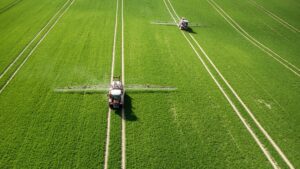Three quarters of the honeys produced around the world contain neonicotinoids, a family of pesticides known for its role in the decline of bees. This is the conclusion of a study published today in the prestigious journal Science by an interdisciplinary group of the University of Neuchâtel (UniNE) and the Botanical Garden of the City of Neuchâtel. However, the measured concentrations of neonicotinoids remain below the maximum permitted levels for human consumption.
Neonicotinoids occupy one-third of the market share of pesticides, mainly on large-scale crops (maize, rapeseed, beetroot), against insect pests, which alter the nervous system, causing paralysis and death. As these substances pass into the pollen and nectar of the flowers, the bees swallow them when they forge. Now, honey is nothing but the result of the transformation, by the bees, of the nectar in reserve of food. Hence the relevance of measuring the quantities of neonicotinoids.
During this research conducted between 2015 and 2016, scientists analyzed 198 honey samples from around the world. They measured the concentration of five most commonly used neonicotinoids (acetamiprid, clothianidin, imidacloprid, thiacloprid and thiamethoxam).
The collection of honeys used results from an action of citizen science initiated by the Botanical Garden of the City of Neuchâtel. “All these samples were given to us,” explains its director Blaise Mulhauser. They were taken at random from the travel of more than 100 donors. We have just oriented our choices so as to favor honeys of small producers or at least of well-defined regions, in order to obtain the best geographical representation. “
With the large quantities of nectar it harvests each year, the bee has been used as an elegant way to probe the presence of pesticides in our environment. “A bee fetches nectar up to a distance of twelve kilometers from its hive, thus covering a considerable area,” says Alexander Aebi, teacher and research in agroecology at the UniNE and beekeeper.
This work was made possible thanks to the UniNew Analytical Chemistry Platform (NPAC) of the UniNE. “We have tools that can detect traces of neonicotinoids in complex matrices like honey. These molecules can be quantified with excellent precision at concentrations of the order of one part per ten billion or less, “says Gaétan Glauser, head of NPAC.
Results: 75% of the honey contained at least one of the five substances sought. This rate varied considerably from region to region: 86% of North American samples were contaminated, followed by Asians (80%) and Europeans (79%). The lowest shares of contaminated samples came from South America (57%).
In detail, 30% of all samples contained only one neonicotinoid, 45% contained between two and five, and 10%, four to five. The measured doses did not exceed the standards authorized for human consumption for each individual substance. But for two of the samples containing the five neonicotinoids at a time, the total concentrations exceeded this standard.
“We show that, according to current standards, the vast majority of the samples studied do not concern consumers’ health for the five pesticides studied,” says Edward Mitchell, a professor at the Soil Biodiversity Laboratory and principal author of the article.
However, the situation is more critical for bees. “Our study demonstrates that they are exposed worldwide to concentrations of neonicotinoids that have important effects on their behavior, physiology and reproduction,” says Alebi.
In addition to the actual dosage of individual neonicotinoids, the effect of organisms (bees, humans, etc.) on the presence of several toxic substances at the same time, commonly known as the cocktail effect, remains. The question remains broadly open.
“With more than 350 synthetic pesticides used in Switzerland that can degrade into even more compounds, the metabolites and combinations are therefore endless, making any study complete illusory,” observes Edward Mitchell. We are therefore limited to short-term research, often focused on the only ‘active’ compound. Thus, we do not take into account the adjuvants (other molecules included in the commercial formulation) or the presence of metabolites, sometimes as toxic, if not more than the ‘active’ compounds themselves. “
Source: University of Neuchâtel












